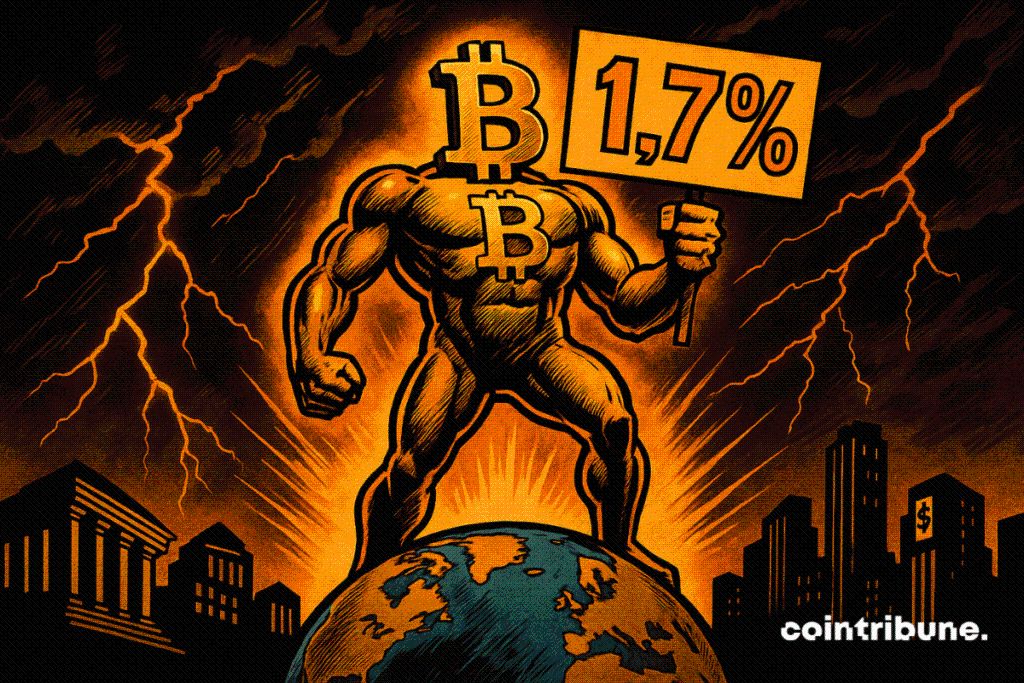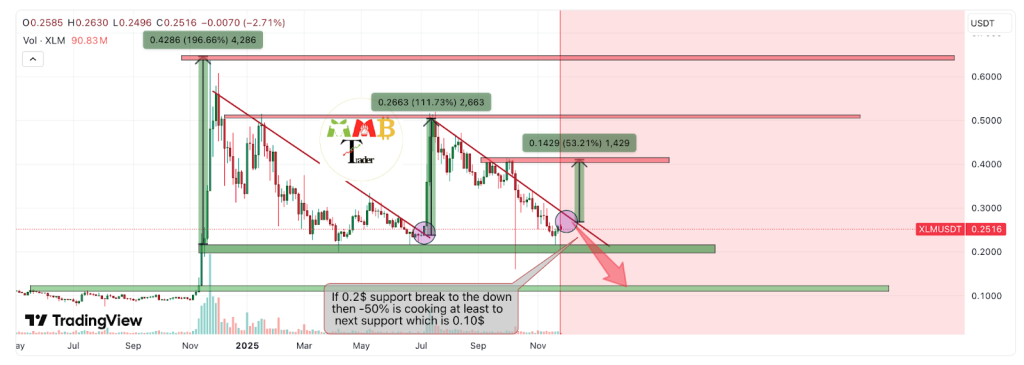In 16 years, Bitcoin went up to 1.7% of global money.
— River (@River) August 15, 2025
Where will we be in another 16? pic.twitter.com/OthKh0xFlv
River Reports Bitcoin’s Surge In Monetary Share
By:Cointribune
Quietly, but surely, bitcoin is establishing itself in the global monetary architecture. The flagship crypto asset has just crossed a symbolic threshold : its market capitalization now amounts to nearly 1.7 % of the planetary money supply. A still limited weight compared to state currencies and precious metals, but indicative of a deep trend: the rise of a decentralized asset within a system dominated for decades by fiat money and traditional reserves.

In brief
- Bitcoin now reaches 1.7 % of the global money supply, according to an analysis by the company River.
- This estimate is based on a comparison between BTC capitalization (2.29T$) and a global money basket of 138T$ (M2 of major currencies + gold).
- River deliberately excludes silver, platinum, and other industrial metals to avoid distorting the analysis.
- This rise of BTC reflects growing interest in decentralized assets amid the erosion of fiat currencies’ purchasing power.
The growing weight of Bitcoin in the global money supply
The American company River, specialized in financial services linked to bitcoin, published a comparative analysis between BTC capitalization and the total global money supplies, while the asset has just bounced back after Jerome Powell’s speech .
According to its calculations, “in 16 years, bitcoin has risen to 1.7 % of the global money supply”, based on a global basket of 112.9 trillion dollars of fiat currencies (M2) and 25.1 trillion for gold, excluding silver and industrial metals.
This estimate is based on a temporary market capitalization reached by BTC earlier this month, namely 2.4 trillion dollars. Currently, Bitcoin’s valuation is around 2.29 trillion, slightly adjusting its share to about 1.66%.
Although marginal compared to total global liquidity volumes, this figure reveals a notable evolution. Bitcoin, originally conceived as a response to the 2008 financial crisis, is gradually integrating the spectrum of major monetary asset classes. Several key elements help to contextualize this progress :
- BTC capitalization : approximately 2.29 trillion dollars, against a total of 138T$ (fiat currencies + gold) analyzed ;
- Current share of Bitcoin in the global money supply : 1.66 %, with a peak of 1.7 % reached in early August ;
- Methodology used by River : aggregation of M2 money supplies of major world currencies, combined with the valuation of physical gold stock ;
- Deliberate exclusion of certain metals : silver, platinum, and palladium are not included in comparisons to avoid biases linked to industrial uses ;
- Macroeconomic issues : the ongoing dilution of fiat currencies fuels interest in limited-issue assets, such as bitcoin.
In a world where expansionary monetary policies remain the norm, this paradigm shift deserves increased attention. The rise of bitcoin, even partially, constitutes a concrete indicator of the slow but tangible transformation of confidence granted to traditional currencies.
A Powell speech that boosts bitcoin
During the highly anticipated speech at the Jackson Hole Symposium, the Chairman of the U.S. Federal Reserve, Jerome Powell, delivered a message closely watched by the markets.
“Our policy rate is today 100 basis points closer to a neutral rate than it was a year ago”, he said, before specifying that “the stability of the unemployment rate and other labor market indicators allow us to proceed cautiously in adjusting our monetary stance”.
These remarks were interpreted as an implicit opening to a future rate cut, increasing the likelihood of a short-term monetary pivot.
Such a prospect of monetary easing had an immediate effect on the crypto market. Within a few hours, the bitcoin price recorded an increase of over 2 %, reaching a peak around 116,000 dollars.
This reaction is consistent with the dynamics observed in recent years, in a context of expanding global liquidity; cryptos have often benefited from favorable conditions. According to CME Group data , 75 % of investors now expect a 25 basis point cut as early as September.
The correlation between U.S. monetary policy and crypto evolution raises questions about bitcoin’s nature in the global financial ecosystem. If it continues to react positively to easing signals, it could strengthen its status as a liquidity-sensitive asset, similar to gold or even tech stocks. However, unlike these, bitcoin also benefits from its deflationary nature, giving it a hybrid status, between a less volatile store of value than stocks and a bet on the future of post-banking finance. Its evolving share in the global money supply and sensitivity to central bank decisions reveal a future where Fed policies will impact bitcoin as much as traditional currencies.
0
0
Disclaimer: The content of this article solely reflects the author's opinion and does not represent the platform in any capacity. This article is not intended to serve as a reference for making investment decisions.
PoolX: Earn new token airdrops
Lock your assets and earn 10%+ APR
Lock now!
You may also like
Do Kwon Wants Lighter Sentence After Admitting Guilt
Cointribune•2025/11/29 13:18

Bitwise Expert Sees Best Risk-Reward Since COVID
Cointribune•2025/11/29 13:18

Stellar (XLM) Price Prediction: Can Bulls Push Toward $0.30 in December?
Coinpedia•2025/11/29 12:57

21Shares XRP ETF Set to Launch on 1 December as ETF Demand Surges
Coinpedia•2025/11/29 12:57
Trending news
MoreCrypto prices
MoreBitcoin
BTC
$90,718.54
+0.16%
Ethereum
ETH
$2,994.92
-0.88%
Tether USDt
USDT
$1
-0.01%
XRP
XRP
$2.21
+1.50%
BNB
BNB
$878.27
-0.04%
Solana
SOL
$137.13
-0.15%
USDC
USDC
$0.9997
-0.03%
TRON
TRX
$0.2812
+0.15%
Dogecoin
DOGE
$0.1486
-0.71%
Cardano
ADA
$0.4177
-0.63%
How to buy BTC
Bitget lists BTC – Buy or sell BTC quickly on Bitget!
Trade now
Become a trader now?A welcome pack worth 6200 USDT for new users!
Sign up now